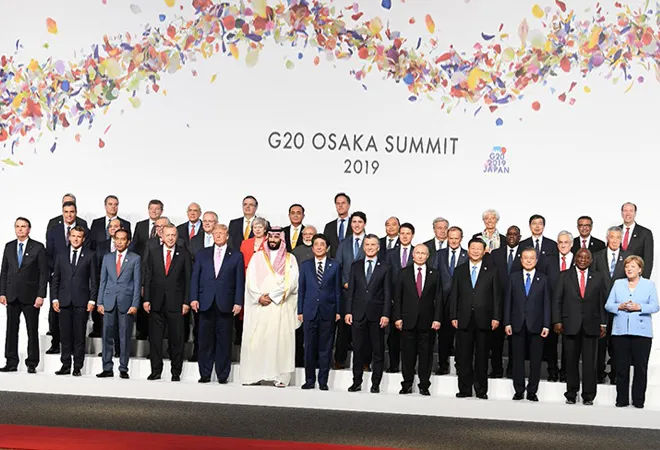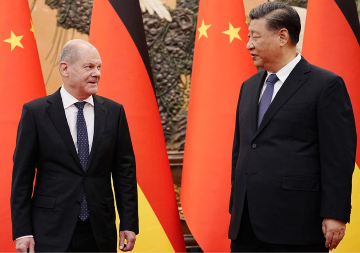
Past eighteen months have been a harrowing experience for international goods and services markets across the globe, principally due to the mounting trade tensions among major economies of the world. The United States of America started it unilaterally, which resulted in retaliations from China and other countries – mainly in the form of more unilateral tariff impositions – which is rapidly taking the global trade and economy to the brink of a disaster.
Needless to say, if global trade and business keep on getting hit badly then international financial markets will be the next in the list of serious collateral damages of this trade war, and a full-blown world economic crisis will be conjured in just a matter of time.
This trajectory of events seemed to be largely avoidable even a few months back while the talks were on, but the breakdown of negotiation between the USA and China has brought back real chance of a worldwide crisis happening.
G-20 summit at Osaka, starting today that is 28th June, offers the best chance of resumption of talks between the presidents of these two countries. However, in spite of US Treasury Secretary conveying that both the countries are at about 90 percent of the way towards a deal, a Bank of America and Merrill Lynch survey of investors finds that about two-third of them expect no deal but a ceasefire on imposition of further tariffs.
Meanwhile, with the belief that trade wars are good and easy to win President Trump is now targeting other countries, including India. Before arriving at G-20 venue he tweeted that he is looking forward to speak with Prime Minister Narendra Modi about “the fact that India, for years having put very high tariffs against the United States, just recently increased the tariffs even further”. He continued, “This is unacceptable and the tariffs must be withdrawn!” However, the reality is that India has only reacted to the unilateral tariff imposition and GSP (Generalised System of Preferences) withdrawal by the USA. And Indian reaction, by any standard, cannot be termed as disproportionate.
Prime Minister Narendra Modi is expected to meet Presidents of the USA and China in the sidelines of G-20, and hopefully the discussions will lead towards a direction where resolutions of existing problems in trade relations can be found.
With World Trade Organisation (WTO) in a comatose state, the summit remains the best hope for restoration of international trade order for the time being as G-20 countries contribute 89.6 percent of world GDP (in Purchasing Power Parity), 72.4 percent of world exports, 62.3 percent of world imports, around two-third of world population, and supply 79.0 percent of total foreign direct investment (FDI-abroad) of the world. Currently, there is no better platform to discuss the prevailing trade and economic chaos. Economic, political and strategic heft of the G-20 formation makes it the forum, to which rest of the world can look upon with hope – as can be seen in Table 1.
|
TABLE 1: Economy and Trade Indicators of G-20 countries
|
|
GDP (in PPP)
$ trillion |
GDP real growth rate (%) |
Exports
($ billion) |
Imports
($ billion) |
Trade surplus (+) / deficit (-)
($ billion) |
FDI - abroad
($ trillion) |
| Argentina |
0.922 |
2.9 |
58.45 |
63.97 |
-5.52 |
0.041 |
| Australia |
1.248 |
2.2 |
231.60 |
221.00 |
10.60 |
0.510 |
| Brazil |
3.248 |
1.0 |
217.20 |
153.20 |
64.00 |
0.359 |
| Canada |
1.774 |
3.0 |
423.50 |
442.10 |
-18.60 |
1.371 |
| China |
23.210 |
6.9 |
2216.00 |
1740.00 |
476.00 |
1.383 |
| France |
2.856 |
2.3 |
549.90 |
601.70 |
-51.80 |
1.429 |
| Germany |
4.199 |
2.5 |
1434.00 |
1135.00 |
299.00 |
2.298 |
| India |
9.474 |
6.7 |
304.10 |
452.20 |
-148.10 |
0.155 |
| Indonesia |
3.250 |
5.1 |
168.90 |
150.10 |
18.80 |
0.021 |
| Italy |
2.317 |
1.5 |
496.30 |
432.90 |
63.40 |
0.672 |
| Japan |
5.443 |
1.7 |
688.90 |
644.70 |
44.20 |
1.547 |
| Mexico |
2.463 |
2.0 |
409.80 |
420.80 |
-11.00 |
0.244 |
| Russia |
4.016 |
1.5 |
353.00 |
238.00 |
115.00 |
0.471 |
| Saudi Arabia |
1.775 |
-0.9 |
221.10 |
119.30 |
101.80 |
0.056 |
| South Africa |
0.767 |
1.3 |
94.93 |
89.36 |
5.57 |
0.270 |
| South Korea |
2.035 |
3.1 |
577.40 |
457.50 |
119.90 |
0.345 |
| Turkey |
2.186 |
7.4 |
166.20 |
225.10 |
-58.90 |
0.047 |
| UK |
2.925 |
1.7 |
441.20 |
615.90 |
-174.70 |
2.110 |
| USA |
19.490 |
2.2 |
1553.00 |
2361.00 |
-808.00 |
5.711 |
| EU |
20.850 |
2.3 |
1929.00 |
1895.00 |
34.00 |
8.411 |
|
* All figures (except EU export and import) are figures for the year 2017.
* GDP in purchasing power parity (PPP) figures are in 2017 current US dollar value.
* EU export and import figures are for 2016.
Source: The World Factbook, Central Intelligence Agency (CIA), USA |
Global economy is now facing more potential supply-side shocks in the form of continued trade wars and possible spike in oil prices. Moreover, as tariffs and higher fuel prices take away disposable incomes from the hands of the consumers. All these supply-side shocks will invariably result into loss of aggregate demand and slowdown in the consumption growth. In current uncertain scenario, private companies are then likely to reduce capital expenditure and investment.
Under these conditions, a prolonged and more severe trade war is sure to usher in a global recession. While tackling 2008 crisis, governments across the world employed fiscal and monetary stimulus policies. But, eleven years later those fiscal and monetary instruments – across all G-20 countries – are sufficiently blunted, as can be observed in Table 2.
Almost all G-20 countries, except for Brazil and Turkey, are now operating with quite low rates of interest. And, the problem with already low interest rates is that they cannot go in the negative zones across the world – making the instrument sufficiently ineffective.
Fiscal stimulus, after 2008, were injected by increasing public debt and subsequently increasing budget deficits. Once again, Table 2 shows that public debts of G-20 countries – except for Russia – are much higher than the pre-2008 level. On top of this, the reliance on external debt across these countries has increased considerably. All these imply that if there are (repayment) defaults by even a few countries initially - the crisis will precipitate and spill over to other countries.
This makes the current world economic scenario far more precarious than it was in 2008.
| TABLE 2: Monetary and Fiscal Policy Constraints of G-20 Countries |
|
Real rate of interest
(%) |
Budget surplus (+) / deficit (-)
(% of GDP) |
Public debt
(% of GDP) |
External Debt
($ trillion) |
| Argentina |
4.70 |
-6.0 |
57.6 |
0.215 |
| Australia |
1.50 |
-0.5 |
40.8 |
1.714 |
| Brazil |
42.00 |
-1.1 |
84.0 |
0.547 |
| Canada |
0.20 |
-1.0 |
89.7 |
1.608 |
| China |
0.30 |
-3.8 |
47.0 |
1.598 |
| France |
5.11 |
-2.6 |
96.8 |
5.360 |
| Germany |
4.34 |
1.3 |
63.9 |
5.326 |
| India |
5.50 |
-3.5 |
71.2 |
0.502 |
| Indonesia |
6.50 |
-2.7 |
28.8 |
0.344 |
| Italy |
2.50 |
-2.3 |
131.8 |
2.444 |
| Japan |
1.20 |
-3.5 |
237.6 |
3.240 |
| Mexico |
1.10 |
-1.1 |
54.3 |
0.446 |
| Russia |
5.00 |
-1.4 |
15.5 |
0.540 |
| Saudi Arabia |
2.86 |
-8.9 |
17.2 |
0.205 |
| South Africa |
4.60 |
-4.4 |
53.0 |
0.156 |
| South Korea |
1.20 |
1.4 |
39.5 |
0.385 |
| Turkey |
26.77 |
-1.5 |
28.3 |
0.452 |
| UK |
-1.20 |
-1.9 |
87.5 |
8.126 |
| USA |
2.00 |
-3.4 |
78.8 |
17.910 |
| EU |
1.88 |
-3.0 |
86.8 |
29.270 |
|
* All data (except otherwise mentioned) are 2017 figures.
* France and Germany real rate of interest are 2016 figures; Saudi Arabia nominal rate is April 2019 rate based on SIBOR (Singapore Inter-bank Offered Rate); Turkey May 2019 nominal rate based on TRLIBOR (Turkish Inter-bank Offered Rate); EU nominal rate is April 2019 commercial loan rate of size more than € 1 million for 10 years or more; rest are taken from World Bank Database (UK rate for 2014)
* Data in last three columns are taken from The World Factbook, Central Intelligence Agency (CIA), USA
Other Data Sources: https://ycharts.com/indicators/categories/interest_rates , https://www.ceicdata.com/en |
President Trump and President Xi probably realise that a global crisis does not bode well for their economies, but an unblinking attitude in the present trade stand-off and tit-for-tat measures from both the sides (seemingly to please the domestic constituencies) are bringing the entire world to the brink of an economic crisis. And, if the crisis indeed happens this time, it will be much more difficult to cope with – as mitigating fiscal and monetary policy instruments have been sufficiently blunted in the last decade or so due to over-use. This time it will definitely be different.
Therefore, the all-important set of questions now is – will the G-18 be able to inject some senses into the G-2 at G-20 summit? Will G-20 be able to douse the trade war fire? Will Osaka be able to show some rays of hope to rest of the world?
Negative answers and outcomes of these questions will push the world population towards greater human misery than the one immediately after 2008 crisis.
The views expressed above belong to the author(s). ORF research and analyses now available on Telegram! Click here to access our curated content — blogs, longforms and interviews.




 PREV
PREV


